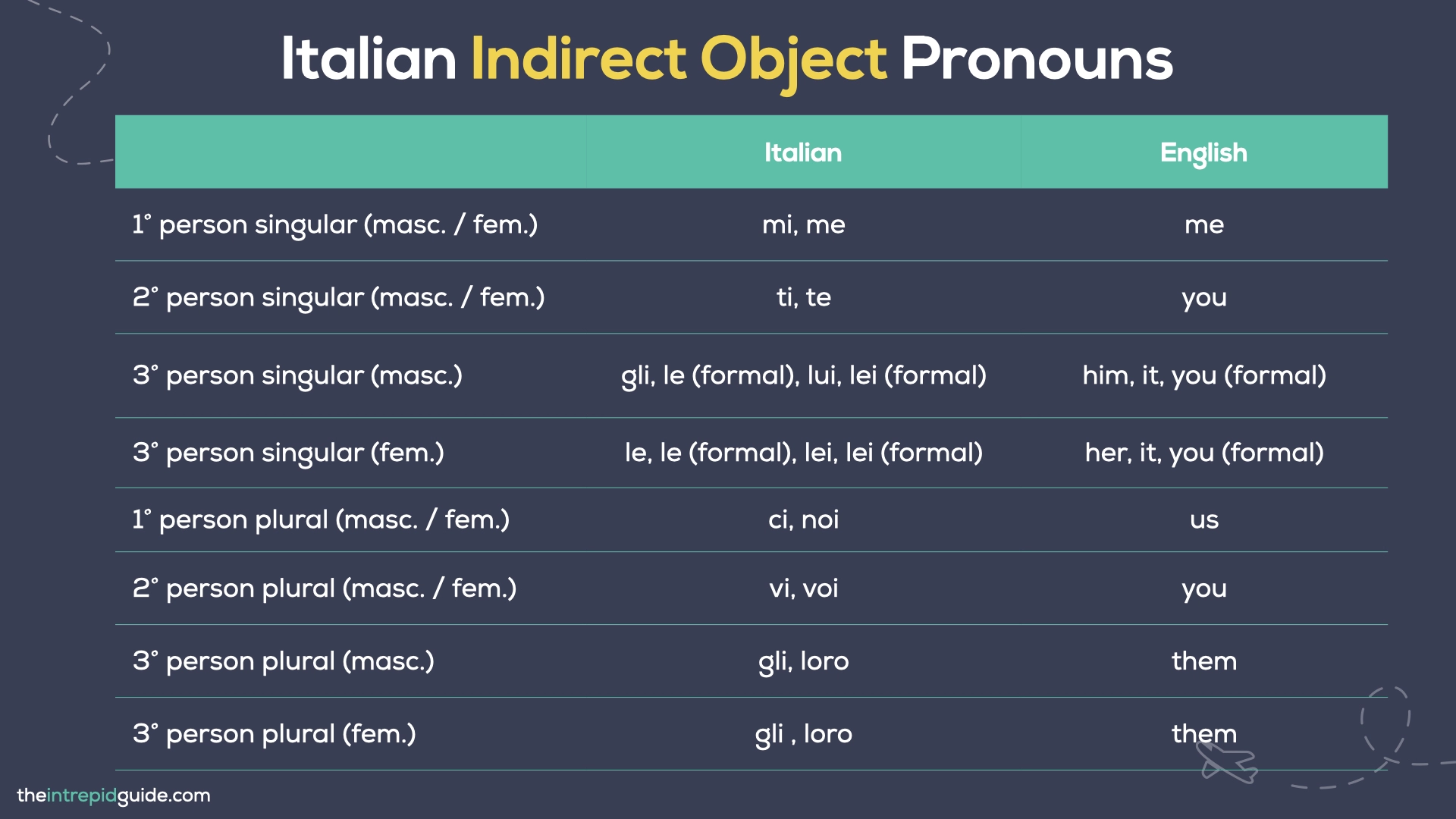Italian indirect object pronouns are essential for everyday conversation, as they indicate to whom or for whom an action is performed. In other words, these pronouns replace the names of people or things that receive the action of the verb indirectly.
Imagine you’re chilling in a cozy restaurant in Naples with your sister, both of you crave something vegetarian because, hey, no meat for you guys! You want to nudge the waiter to suggest a veggie dish. In Italian, you’d casually ask, Può consigliarci un piatto vegetariano? (Can you recommend us a vegetarian dish?). Here, ci is the indirect object pronoun for “to us.”
This example clearly illustrates that indirect object pronouns in Italian are used as indirect complements. They are not the main subjects or the direct objects of sentences. Instead, they link to the verb indirectly, often following small prepositions.
Here are some more examples:
- Lucia ha telefonato a Luca. (Lucia called Luca.) —> Lucia gli ha telefonato. (Lucia called him.)
Gli replaces a Luca.
- Abbiamo pensato a te Angela. (We thought about you, Angela) —> Ti abbiamo pensato. (We thought about you.)
Ti replaces a te Angela.
- A te e Luigi piace viaggiare? (Do you and Luigi like traveling?) —> Vi piace viaggiare? (Do you like traveling?)
Vi replaces a te e Luigi.
This guide will provide you with practical examples to help you understand how and when to use indirect object pronouns in your Italian conversations so you sound like a real local. To see how much you’ve learned, don’t forget to complete the free quiz at the end of this lesson to test your new-found knowledge!
Before we get started, make sure you download your FREE PDF cheat-sheet for this lesson which includes a practical summary of everything you’ll learn in this guide. Just enter your email below and I’ll send it to you straight away.
By the way, want to improve your Italian quickly and having fun doing it?
I thought so.
If you’re a beginner, I recommend Intrepid Italian, my comprehensive self-paced programme that teaches you through the power of my unique 80/20 method. The course covers everything you need to know as a beginner in Italian (including how to use pronouns). Join now for lifetime access and my 30-Day “Celebrate with a Spritz” money-back guarantee by clicking here.
Or if you’re already at the intermediate level, why not enrol in Intrepid Italian for Advanced Beginners (A2) or Intrepid Italian for Intermediates (B1), my more advanced programmes that helps you master the trickiest aspects of Italian grammar while as you edge closer to fluency in Italian.
When you start learning Italian, it’s pretty common to keep repeating the same basic phrases and words, but if you’re gunning for fluency, it’s time to shake things up a bit. The key? Familiarize yourself with Italian pronouns to inject rhythm into your sentences!
Cominciamo! (Let’s get started!)
Italian Indirect Object Pronouns Chart
Similar to Italian direct object pronouns, indirect object pronouns have both atonic (unstressed) and tonic (stressed) forms.
| Indirect Object Pronouns | |||
|---|---|---|---|
| Italian | English | ||
| Unstressed (Atonic) | Stressed (Tonic) | ||
| 1° person singular (masc. / fem.) | mi | me | me |
| 2° person singular (masc. / fem.) | ti | te | you |
| 3° person singular (masc.) | gli, le (formal) | lui, lei (formal) | him, it, you (formal) |
| 3° person singular (fem.) | le, le (formal) | lei, lei (formal) | her, it, you (formal) |
| 1° person plural (masc. / fem.) | ci | noi | us |
| 2° person plural (masc. / fem.) | vi | voi | you |
| 3° person plural (masc.) | gli | loro | them |
| 3° person plural (fem.) | gli | loro | them |
How to use Italian Indirect Object Pronouns
Let’s explore these differences in more detail to better understand their usage.
Unstressed (atonic) indirect object pronouns in Italian
What they are: these pronouns replace nouns after verbs that use the preposition a (to), like offrire (to offer), parlare (to speak), dire (say), dare (to give), and others.
Placement: typically before the verb, the preposition a is not repeated
Here are some examples:
- Telefonerò ai miei genitori domani. (I will call my parents tomorrow.) —> Gli telefonerò domani. (I will call them tomorrow.) – gli = ai miei genitori.
- Porto sempre dei tulipani a mia nonna. (I always bring tulips to my grandma.) —> Le porto sempre dei tulipani. (I always bring her tulips.) – le = a mia nonna.
- Ho mandato una cartolina ai nostri amici. (I sent a postcard to our friends.) —> Gli ho mandato una cartolina. (I sent them a postcard.) – gli = ai nostri amici.
4 Exceptions in Italian pronoun positioning:
1. With infinitive, imperative, or gerund forms, these pronouns follow the verb, forming a single word:
- Infinitive example: Ho deciso di regalarvi una bella vacanza. (I have decided to give you a nice vacation.) – regalarvi = regalare a voi.
- Imperative example: Telefonami subito, ho delle novità. (Call me immediately, I have some news.) – telefonami = telefona a me.
- Gerund example: Nicola ha conquistato la sua ragazza dedicandole una canzone. (Nicola won over his girlfriend by dedicating a song to her.) – dedicandole = dedicando a lei.
2. The pronoun loro (them) is always placed after the verb, regardless of the tense. For example: Ho datoloro delle caramelle. (I gave them some candies).
3. With modal verbs, and expressions like stare per + infinitive, and finire di + infinitive, these pronouns can be placed either before or after the verb:
- Modal verbs example: Vi voglio regalare un quadro <—> Voglio regalarvi un quadro (I want to give you a painting).
- Stare per + infinitive example: La sto per andare a prendere <—> Sto per andarla a prendere (I’m about to go pick her up).
- Finire di + infinitive example: Ti finisco di raccontare dopo cena <—> Finisco di raccontarti dopo cena (I’ll finish telling you after dinner).
4. When preceded by ecco (here), these pronouns go after the adverb, forming a single word: Ecco a te i libri che desideravi —> Eccoti i libri che desideravi (Here are the books you wanted).
Stressed (tonic) indirect object pronouns in Italian
What they are: these pronouns are used to emphasize the indirect object or when the verb is followed by prepositions other than a.
Placement: always after the verb, the preposition is always repeated.
Here are some examples:
- Non intrometterti, Michela mi sta parlando. —> Non intrometterti, Michela sta parlando a me. (Don’t interfere, Michela is talking to me). Here, using the tonic pronoun me instead of the atonic one mi emphasizes the speaker.
- Ieri ho parlato con Valeria. (Yesterday I spoke with Valeria.) —> Ieri ho parlato con lei. (Yesterday I spoke with her).
- Ti sei ricordato di comprare il regalo per i tuoi genitori? (Did you remember to buy the gift for your parents?) —> Ti sei ricordato di comprare il regalo per loro? (Did you remember to buy the gift for them?)
Attenzione!: when the 3° person indirect object pronoun refers to the same person performing the action, use sé for clarity:
- Anna pensa solo a lei. (Anna thinks only about her.) —> Anna pensa solo a sé. (Anna thinks only about herself). Here, sé specifically refers to Anna herself, emphasizing that her thoughts are focused on herself rather than on others.
Stefano ha comprato i biglietti per lui. (Stefano bought tickets for him.) —> Stefano ha comprato i biglietti per sé. (Stefano bought tickets for himself.). In this instance, sé clearly indicates that Stefano bought the tickets for himself.
Italian Indirect Object Pronouns Quiz
Let’s test your knowledge of Italian indirect object pronouns. Fill in the blanks in these sentences using the correct indirect object pronoun.
If you found this lesson powerful, then you’ll love Intrepid Italian, my series of online self-paced video courses that break down everything you need to know about Italian using my 80/20 method. Visit IntrepidItalian.com for more details.
 Are you a beginner or an intermediate Italian learner? Got a trip coming up or want to communicate with your Italian partner or relatives in Italian? Learn Italian with my unique 80/20 method
Are you a beginner or an intermediate Italian learner? Got a trip coming up or want to communicate with your Italian partner or relatives in Italian? Learn Italian with my unique 80/20 method
Registrations are now open to join Intrepid Italian, my new series of online video courses that use my unique 80/20 method. You’ll go from a shy, confused beginner to a proficient and confident intermediate speaker, with me as your trusty guide.
You’ll finally be able to connect with your Italian partner, speak to your relatives and enjoy authentic travel experiences in Italy that you’ve always dreamed of, and so much more.
As a native English speaker who learned Italian as an adult, I know what it’s like to feel hopeless and lack the confidence to speak. I know what it’s like to start from scratch and to even go back to absolute basics and learn what a verb is!
Intrepid Italian was created with YOU in mind. I use my working knowledge of the English language to help you get into the ‘Italian mindset’ so you can avoid the common pitfalls and errors English speakers make – because I made them once too! I break everything down in such a way that it ‘clicks’ and just makes sense.
No matter what your level is, there is an Intrepid Italian course for you, including:
- 🇮🇹 Intrepid Italian for Beginners (A1)
- 🇮🇹 Intrepid Italian for Advanced Beginners (A2)
- 🇮🇹 Intrepid Italian for Intermediates (B1)
You can join 1, 2, or all 3 courses, it’s entirely up to you. The best part is that you have lifetime access so you learn anytime, anywhere and on any device.
As your guide, I walk you through each lesson, step-by-step, using my unique 80/20 method. My approach is different from traditional methods because I teach you the most important 20% of the language right from the beginning so you can start to speak straight away.
Each course includes video lessons, audio exercises, downloadable worksheets, bonus guides, a private support community, and lifetime access all designed to streamline your learning while having fun.
It even comes with my famous “Celebrate with a Spritz Guarantee”. After 30 days of using Intrepid Italian, if you don’t want to celebrate your new-found Italian skills with an Aperol Spritz, you don’t have to pay a penny! Cheers! 🥂
Join Intrepid Italian here and start learning today!
Ci vediamo lì! (See you there!)
Learning Italian? Check out these Italian language guides
- Italian for Beginners | How to Learn Italian in 3 Simple Steps
- TOP 100 Most Common Italian Words (Plus PDF Cheat-Sheet & Quiz)
- Italian Prepositions:The Only Guide You’ll Ever Need (PLUS Chart)
- 17 Weird Italian Superstitions Italians ACTUALLY Live By
- 17 Must-Know Italian Hand Gestures: The Ultimate Guide
- 10 Ways Natives REALLY Say ‘You’re Welcome’ in Italian
- How to say ‘Please’ in Italian in 9 Ways Like a Native
- 41 Italian Greetings: How to Say ‘Hello’ in Italian Like a Local
- 125 Most Common Italian Phrases for Travel You’ll Ever Need [PLUS Printable]
- 8 DEADLY mistakes in Italian (& How to Avoid Them)
- How to Conjugate Italian Verbs in 3 Simple Steps [Italian for Beginners]
- Is Italian Hard to Learn? 7 Common Mistakes & How to Avoid Them
- Master Days of the Week in Italian (7 Simple Memory Hacks)
- Italian Numbers: How to Count in Italian From 0 to 1 Billion (Plus PDF Download)
- How to Order Food & Drinks in Italian [Italian for Beginners]
- 15 Italian Words You Should NEVER Mispronounce [& How Not To]
- 11 Effective Hacks That’ll Help You Learn Italian So Much Faster
- Top 14 Italian Words You Should NEVER Say [& What to Use Instead]
- 20 Hilarious Everyday Italian Expressions You Should Use
- Romanesco: 25 Cool Roman Dialect Words You Should Use in Rome
- 10 Reasons Why Learning Italian Will Change Your Life
- 10 Italian Expressions Italians Love Saying
- 10 Italian Phrases That Will Instantly Make You Sound more Italian
- Funny Italian Sayings: 26 Food-Related Insults You Won’t Forget
- 15 Romantic Italian Films That’ll Make You Love Italy Even More
- How to Master Common Italian Phrases for Travel (Like a Local!)
Like it? Pin it for later!
Over to you!
Did you enjoy this lesson? Do you have a question? Let me know using the comments section below or join me on social media @intrepidguide or @intrepiditalian to start a conversation.
Thanks for reading and I hope you enjoyed this post.
Like what you see? Subscribe using the form below to have all of my posts delivered directly to your email.




